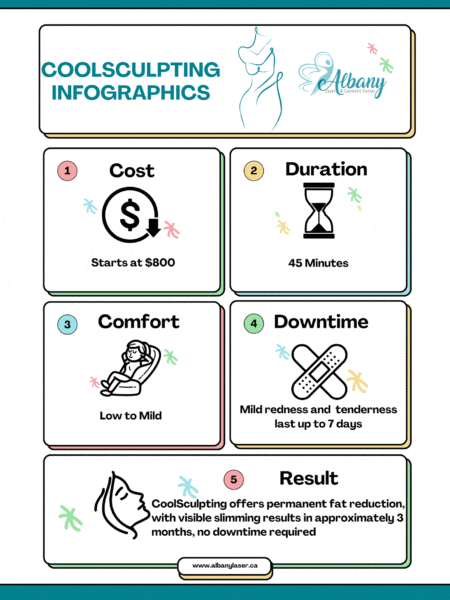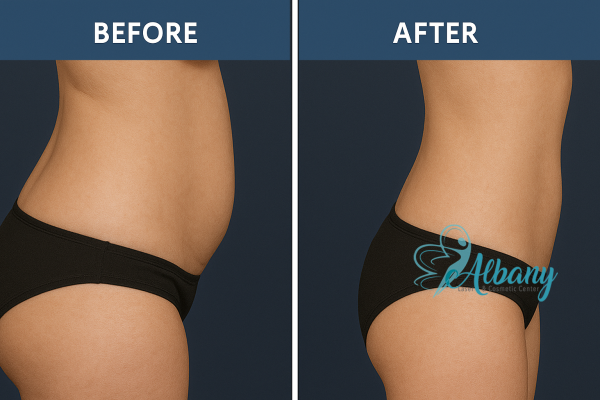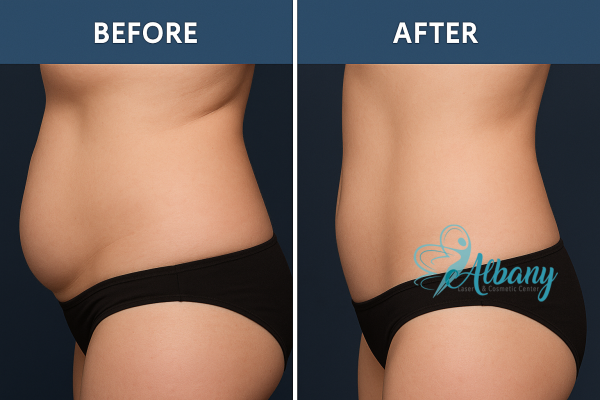Best CoolSculpting Edmonton: Fat Freezing
If you’re struggling with stubborn fat that won’t respond to diet and exercise, CoolSculpting At Albany Cosmetic and Laser Center in Edmonton offers a non-surgical solution that delivers real, lasting results. We specialize in different body shaping procedures including CoolSculpting treatment that target and eliminate fat cells through controlled cooling technology through fat freezing.
Whether you’re looking to slim your abdomen, love handles, thighs, or under the chin, our personalized fat-freezing plans help you sculpt your body safely and effectively—with no surgery, no downtime, and no guesswork under medical supervision.
Coolsculpting Summary

Treatment Cost
Treatment Benefits
Expected Results
Level of Discomfort
Understanding CoolSculpting Edmonton: How It Works
CoolSculpting is an FDA-approved procedure designed to target and permanently eliminate fat cells from common trouble areas like the abdomen, thighs, flanks, and chin. Ideal candidates are close to their target weight but struggle with persistent fat deposits resistant to diet and exercise. The treatment is quick, safe, and effective, resulting in noticeable slimming and improved body contours.
For further information about the science and effectiveness of cryolipolysis (CoolSculpting), visit the Cleveland Clinic’s informative guide.
Benefits of CoolSculpting Edmonton at Albany Cosmetic and Laser Centre
Benefits include permanent fat cell reduction, natural-looking results, and quick treatment sessions that fit into your schedule. Since CoolSculpting doesn’t require incisions or anesthesia, you can return to normal activities immediately. It’s an ideal option for those looking to contour their body and boost confidence—without disrupting their daily routine.
We carry different applicators
At Albany Cosmetic and Laser Centre, we pride ourselves on offering a several applicators to fit your needs. Our selection includes:
- CoolMini
- CoolSmooth Pro
- Advantage Petite
- CoolAdvantage
- Advantage Plus
Each applicator fits a specific body parts, ensuring precision and effectiveness in achieving your aesthetic goals. Learn more about our and discover the best fit for you.
CoolSculpting Edmonton Results: Before and After Pictures


Patients undergoing CoolSculpting often observe noticeable fat reduction in treated areas within three weeks, with optimal results typically visible after two to three months. The procedure effectively targets areas like the abdomen, flanks, thighs, and under the chin, leading to a more contoured and toned appearance. Individual results may vary based on personal factors and treatment areas.
CoolSculpting Treatment Preparation and Aftercare Timeline
3 to 7 Days Before (Preparation)
- Maintain a stable weight and continue a healthy diet and exercise routine.
- Avoid anti-inflammatory medications to reduce the risk of bruising.
- Ensure the treatment area is free from cuts, bruises, or skin conditions.
Treatment Day (What to Expect)
- Arrive at the clinic wearing comfortable clothing.
- The practitioner will mark the treatment areas and apply a gel pad to protect your skin.
- The CoolSculpting applicator will be positioned, and controlled cooling will commence.
- During the procedure, you can relax, read, or use electronic devices.
1 to 7 Days After (Immediate Aftercare)
- Possible side effects include redness, swelling, or tenderness in the treated area, which typically resolve within a few days. Click here for more aftercare tip.
- Engage in light physical activity to promote circulation, but avoid intense workouts for the first few days.
- Maintain hydration and a balanced diet to support the body’s natural elimination process.
7 to 14 Days (Ongoing Aftercare)
- Continue with regular activities and exercise routines.
- Monitor the treated areas for any changes or concerns and consult the clinic if necessary.
3 to 6 Months (Long-Term Maintenance)
- Adhere to a healthy lifestyle to preserve the results.
- Schedule follow-up appointments to assess progress and determine if additional treatments are needed.
Coolsculpting Frequently Asked Questions
What exactly is CoolSculpting?
CoolSculpting is a non-surgical treatment using cryolipolysis to freeze and destroy unwanted fat cells. These cells are then naturally processed and eliminated from the body, permanently reducing the fat layer in targeted areas.
Am I a good candidate for CoolSculpting?
Ideal candidates have stubborn fat deposits despite diet and exercise, maintain a healthy lifestyle, and have realistic expectations about results. It is not intended as a weight-loss procedure for obesity.
How Many Sessions Are Needed?
How long does it take to see results from CoolSculpting?
Initial results can be seen as early as three weeks after treatment, with full results developing over two to three months as the body naturally eliminates the frozen fat cells.
Is CoolSculpting painful?
The treatment typically causes minimal discomfort. Initially, patients feel intense cold, followed by mild numbness. Post-treatment sensations can include minor tenderness or tingling, resolving within days.
What areas can be treated with CoolSculpting?
Common treatment areas include the abdomen, flanks, thighs, upper arms, under the chin, and back. A consultation can help determine the best areas for your body sculpting needs.
Is CoolSculpting permanent?
Yes, CoolSculpting permanently destroys fat cells in the treated area. However, maintaining a healthy lifestyle is essential to prevent remaining fat cells from expanding.
Can CoolSculpting treat all areas of the body?
CoolSculpting effectively treats common problem areas like the abdomen, love handles, inner and outer thighs, upper arms, back, and double chin.
What should I expect during my CoolSculpting session?
During treatment, a cooling applicator is placed on the targeted area. You may feel suction and cold sensations initially, followed by numbness. Most patients comfortably read, relax, or even nap during their session.
Are there any side effects of CoolSculpting?
Common side effects include mild redness, swelling, bruising, or numbness at the treatment site. These symptoms typically subside quickly without additional care.
Why to get CoolSculpting in Edmonton?
Albany Cosmetic & Laser Centre combines state-of-the-art CoolSculpting technology with highly experienced practitioners. Our personalized approach ensures each patient achieves optimal, satisfying results in a comfortable and welcoming environment.